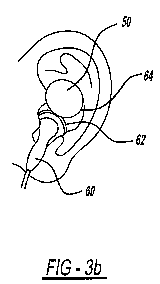Une partie des informations de ce site Web a été fournie par des sources externes. Le gouvernement du Canada n'assume aucune responsabilité concernant la précision, l'actualité ou la fiabilité des informations fournies par les sources externes. Les utilisateurs qui désirent employer cette information devraient consulter directement la source des informations. Le contenu fourni par les sources externes n'est pas assujetti aux exigences sur les langues officielles, la protection des renseignements personnels et l'accessibilité.
L'apparition de différences dans le texte et l'image des Revendications et de l'Abrégé dépend du moment auquel le document est publié. Les textes des Revendications et de l'Abrégé sont affichés :
| (12) Demande de brevet: | (11) CA 2742855 |
|---|---|
| (54) Titre français: | APPAREIL ET PROCEDE D'ANCRAGE D'UNE OREILLETTE |
| (54) Titre anglais: | APPARATUS AND METHOD OF ANCHORING AN EAR PIECE |
| Statut: | Réputée abandonnée et au-delà du délai pour le rétablissement - en attente de la réponse à l’avis de communication rejetée |
| (51) Classification internationale des brevets (CIB): |
|
|---|---|
| (72) Inventeurs : |
|
| (73) Titulaires : |
|
| (71) Demandeurs : |
|
| (74) Agent: | BLAKE, CASSELS & GRAYDON LLP |
| (74) Co-agent: | |
| (45) Délivré: | |
| (86) Date de dépôt PCT: | 2009-11-05 |
| (87) Mise à la disponibilité du public: | 2010-05-14 |
| Licence disponible: | S.O. |
| Cédé au domaine public: | S.O. |
| (25) Langue des documents déposés: | Anglais |
| Traité de coopération en matière de brevets (PCT): | Oui |
|---|---|
| (86) Numéro de la demande PCT: | PCT/US2009/063411 |
| (87) Numéro de publication internationale PCT: | US2009063411 |
| (85) Entrée nationale: | 2011-05-05 |
| (30) Données de priorité de la demande: | ||||||
|---|---|---|---|---|---|---|
|
La présente invention concerne un appareil et un procédé d'ancrage d'une oreillette. Ledit appareil inclut un élément flexible de matériau semi-adhésif expansible pouvant être moulé. Ledit élément flexible possède une forme prédéterminée. Le procédé d'ancrage de l'oreillette inclut l'étape consistant à placer une oreillette dans l'oreille. Ce procédé inclut également l'étape consistant à modeler l'élément flexible en une boule et à placer ledit élément flexible modelé dans une partie de conque de l'oreille, de telle sorte que l'élément flexible modelé soit disposé dans l'oreillette et l'anthélix, et que l'ancre d'oreillette s'étende pour retenir l'oreillette dans l'oreille.
An apparatus and method of anchoring an earpiece is provided.
The apparatus includes a flexible member of moldable expandable, semi -
adhesive
material. The flexible member has a predetermined shape. The method of
anchor-ing an earpiece includes the steps of placing an earpiece in the ear.
The method
also includes the steps of shaping the flexible member into a ball and placed
the
shaped flexible member into the concha portion of the ear, such that the
shaped
flexible member is disposed the earpiece and the antihelix and the earpiece
anchor
expands to retain the earpiece in the ear.
Note : Les revendications sont présentées dans la langue officielle dans laquelle elles ont été soumises.
Note : Les descriptions sont présentées dans la langue officielle dans laquelle elles ont été soumises.

2024-08-01 : Dans le cadre de la transition vers les Brevets de nouvelle génération (BNG), la base de données sur les brevets canadiens (BDBC) contient désormais un Historique d'événement plus détaillé, qui reproduit le Journal des événements de notre nouvelle solution interne.
Veuillez noter que les événements débutant par « Inactive : » se réfèrent à des événements qui ne sont plus utilisés dans notre nouvelle solution interne.
Pour une meilleure compréhension de l'état de la demande ou brevet qui figure sur cette page, la rubrique Mise en garde , et les descriptions de Brevet , Historique d'événement , Taxes périodiques et Historique des paiements devraient être consultées.
| Description | Date |
|---|---|
| Demande non rétablie avant l'échéance | 2013-11-05 |
| Le délai pour l'annulation est expiré | 2013-11-05 |
| Réputée abandonnée - omission de répondre à un avis sur les taxes pour le maintien en état | 2012-11-05 |
| Inactive : Notice - Entrée phase nat. - Pas de RE | 2011-07-21 |
| Inactive : CIB attribuée | 2011-07-14 |
| Inactive : CIB attribuée | 2011-07-14 |
| Inactive : CIB en 1re position | 2011-07-14 |
| Inactive : CIB enlevée | 2011-07-14 |
| Inactive : Page couverture publiée | 2011-07-12 |
| Inactive : Notice - Entrée phase nat. - Pas de RE | 2011-06-29 |
| Inactive : CIB en 1re position | 2011-06-28 |
| Inactive : CIB attribuée | 2011-06-28 |
| Demande reçue - PCT | 2011-06-28 |
| Exigences pour l'entrée dans la phase nationale - jugée conforme | 2011-05-05 |
| Demande publiée (accessible au public) | 2010-05-14 |
| Date d'abandonnement | Raison | Date de rétablissement |
|---|---|---|
| 2012-11-05 |
Le dernier paiement a été reçu le 2011-05-05
Avis : Si le paiement en totalité n'a pas été reçu au plus tard à la date indiquée, une taxe supplémentaire peut être imposée, soit une des taxes suivantes :
Les taxes sur les brevets sont ajustées au 1er janvier de chaque année. Les montants ci-dessus sont les montants actuels s'ils sont reçus au plus tard le 31 décembre de l'année en cours.
Veuillez vous référer à la page web des
taxes sur les brevets
de l'OPIC pour voir tous les montants actuels des taxes.
| Type de taxes | Anniversaire | Échéance | Date payée |
|---|---|---|---|
| Taxe nationale de base - générale | 2011-05-05 | ||
| TM (demande, 2e anniv.) - générale | 02 | 2011-11-07 | 2011-05-05 |
Les titulaires actuels et antérieures au dossier sont affichés en ordre alphabétique.
| Titulaires actuels au dossier |
|---|
| MCKEON PRODUCTS, INC. |
| Titulaires antérieures au dossier |
|---|
| DEVIN BENNER |